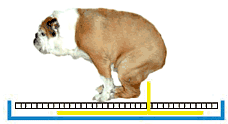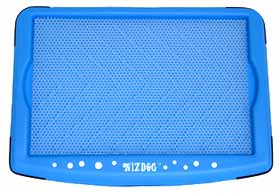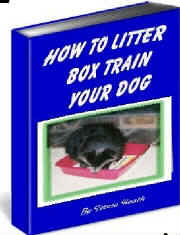|
LITTER BOX TRAINING PHASE
Introducing Your Dog to the Litter Box
Dear Friends, I am so
excited! I just found out about an exciting product that will work
hand in hand beautifully with my litter box training in this e-book you
are reading right now!
It is called "The Wizdog!"
Wizdog consists
of an industrial grade polyethylene plastic tray and a fitted honeycomb
grate.
The Wizdog measures 21" X 28"
with an elimination space of 15.5" X 23.5" and was specifically designed
to fit most daily newspapers (you can also use the store bought pee
pads).
The paper remains under the
grate, preventing your dog or puppy from shredding it.
Liquid waste is channeled
through the grate to the bottom of the tray, preventing paws from coming
in contact with the urine. Solid waste is disposed of by simply
lifting and flipping the grate. The grate is only 3/8" deep and is easy
to clean.
Unlike dog litter systems, Wizdog is a simple and
inexpensive product that does not require the purchase of litter refill.
Wizdog can be used as is, or can
fit either newspaper or training pads to absorb the urine. Below is a
picture of the Wizdog.

Click
Here To Go To Site

This is so great!
Also, if one wizdog is not big
enough for your dog, you can fit two together quite nicely!
As you have already discovered
I am not a supporter of using litter in my boxes anyways!
Remember the litter box or whatever you decide to use for your litter
box must be the adequate size for your dog.
I have found that those plastic under the bed storage bins make
outstanding litter boxes and you can cut down one of the sides if
necessary.
Cats can squeeze into almost any size box to go, but with dogs it is a
different story.
We
started our training with teaching your dog to go potty on paper or pads
due to the fact that 95% of dogs will refuse to go in a box first thing.
Steps for transferring over to a
box:
-
To
break down the steps even smaller to make it even easier for you dog.
Start out by using a tray first with paper or pads in it before you even go on to
the box. (I found an excellent metal tray at Super Walmart which is
actually used for an oil pan). Or you can use the lid part of the under
the bed storage bin for this stage.
-
Let
your dog get accustomed to going potty on the tray for a few days before
introducing the box with higher sides.
-
Next step will be placing the pad or paper in the final box itself and
replacing the tray or lid with the box.
-
Coax your dog to go in the box with leash and collar on, going in and
out giving lots of praise!
-
Give verbal instructions using your choice of words to encourage your
dog to go potty in the box.
-
For
a little while you will want to be very watchful for when your dog goes
potty to make sure he is continuing to go in the box.
-
Since you did such a good job in the preliminary steps you will find
this part of the training to go very quickly.
Another important point....you do not
want to have to change the paper every single time they go potty, so
with the bigger, wider tray or box, you have more room for your doggie to go a
few times before having to change the paper.
This is extremely important for those who will
be leaving their dogs for several hours during the day.
Most dogs will not
want to stand in their own potty mess to go potty again.
So their must be enough room for them to be
able to go potty a few times and still have a spot to stand in.
Thanks to several of my customers who
contacted me about this very problem.
Their dogs were not wanting to go potty in a
regular size (cat litter) box and we put two and two together and I
studied my dogs and realized!!!
The way that cats and dogs differ when it comes
to a litter box is this....dogs need more working room! So they need a
larger box!
Therefore, using something that is easy to climb in will make the
transition to a litter box with higher sides much easier for your dog.
I have a tiny teacup pom
and it cannot climb over much of anything, so that is one reason I tried
using the tray from Walmart first.
Also, graduating from paper flat on the floor to
something like the tray will not be much of a change for them at all.
AS you endeavor to lead your dog on to
using the litter
box of choice, the schedules and training methods you used for
reinforcing the use of the paper are the same for the litter box
itself.
Graduating to a litter
box with higher sides should be the last and final step, it is best if
there is one side that is shorter for easier entrance.
Depending on the size
of your dog you will be able to use a plastic pan with sides about 2
inches high.
Continue to follow the
schedule closely and be consistent and very quickly you will have
discovered that your dog is completely litter box trained!!
Unfortunately, a lot of
dogs take longer to learn to go #2 on the paper or box than #1. For
whatever reason, this is quite common.
All I can say about
that is, your consistency and not letting him off of the paper or box
until he goes is mandatory. If he does not go, put him in the crate, then 15
minutes later try again.
Remember they do not
like to go #2 in the same place where they go #1 that is another
reason you must make sure your box is large enough for that.
And make sure you are
keeping your box as clean as possible with papers or pads being
changed appropriately.
Should you use litter?
**NOTE** There is an
alternative filler I want to mention for your litter box that is much
cheaper than the regular dog or cat litter if you are interested and
that is compressed wood pellets that are used for a wood burning
stove.
From what I have read
it will not hurt them if they eat them and when they urinate in the
pellets they turn to sawdust.
This type of litter can
be thrown in the trash or poured into flower beds. Cost is only about
$2.80 for a 40 pound bad...CHEAP!! These wood pellets can be found at
Home Depot.
I still prefer paper and pads personally
but I am mentioning this for those who might like to try it.
Also, you will want to make sure and keep all of your access links to
this information because you will then have access to any and all
upgrades or new tips that are added from time to time.
With the pellets, As with other
litter it can be kicked and still will need to be
vacuumed on a regular basis.
What to use for your litter box?
Your litter box can be anything that is plastic
or metal, with sides low enough
for your dog to step over easily with enough room for
them to turn around without falling out or feeling restricted.
Again, you must reinforce your
training during the list of times mentioned when you were in the paper
stage. Puppy will eventually go on his or her own.
It might take a couple of days
for puppy to get totally used to the box itself.
Keep using the box this way until puppy is going consistently in the box
without hesitation.
Pick up any stools as soon as
you notice them. This may seem like a lot of work, but let me tell you
it is worth it in the end.
After they learn this method of
going potty you will be so much happier with your puppy and you can go
anywhere with puppy and litter box in tow.
Your dog by this time knows what
you mean when you tell him to go potty and where, so all you have to do is
continue the same procedures you have been using all along.
Congratulations! On Your Litter
Box Success!!!
***Concerning your dog being able
to go potty outside....
After
your dog is completely litter box trained, you have the wonderful option
of your dog being able to go potty if he is outside and if he is not able
or the weather does not permit, he has a potty indoors!!!
All of my dogs and many of my
customers' dogs have done this quite naturally after being litter box
trained. They will do both as needed.
A. Review of Litter Box Training Steps
Step #1 - Get the right mindset
for litter box training your dog. Be confident and determined to be consistent
with all the right actions.
Step #2 - Get a Crate or set
up another favorable confinement situation and
get puppy or dog used to it! Supervision and schedule are key!
Step #3 - Start with Paper or Pad
Training portion of the training.
Set up a daily schedule for
your dog to make the training go easier for you and your dog if you are
using a crate.
S tep #4 - Gradually increase your dog's
roaming territory and do a lot of practice runs until they are using the
paper or pads 100% independently!
Step #5 - Gradual step to a
metal or plastic tray or on to the regular litter box. Enforce the use of the
litter box until 100% success there!
Step #6 - Contact me, the litter box dog expert for any help you might
need. Together we will achieve 100% litter box training success!
Step #7 - Please contact me when you have completed successfully your
litter box training so I can celebrate with you!
To Your
Litter Box Success!

Teresa Heath
Link to Next Page
Email:
doglitterbox@yahoo.com
Worldwide
Pet Sitting Directory /
Profitable Pet Bakery Business
/ Top
Ten Dog E-book List /
SnugglePuppies /
Travel With Your Dog
/
FAQS Page /
Dog
Breeding Secrets Revealed /
Veterinary Secrets Revealed
/
Amazing True Story /
Free Hot Dog
E-books /
Hot Dog Links /
Litter Box Training Supplies /
Homemade
Healthy Dog Food Recipes /
Dog Obedience Training
Secrets /
Ultimate Chihuahua Care Handbook /
Dog
Clipping And Grooming the Easy Way /
Boston
Terrier Secrets / Killer
Pet E-books Page One /
FREE
Dish Network System & Set up / dogshoppe.net 101 Dog Training Tips
/Killer Pet E-books Page Two /
WIZDOG
|

